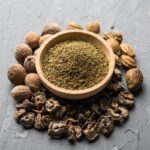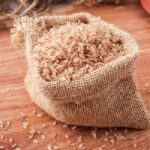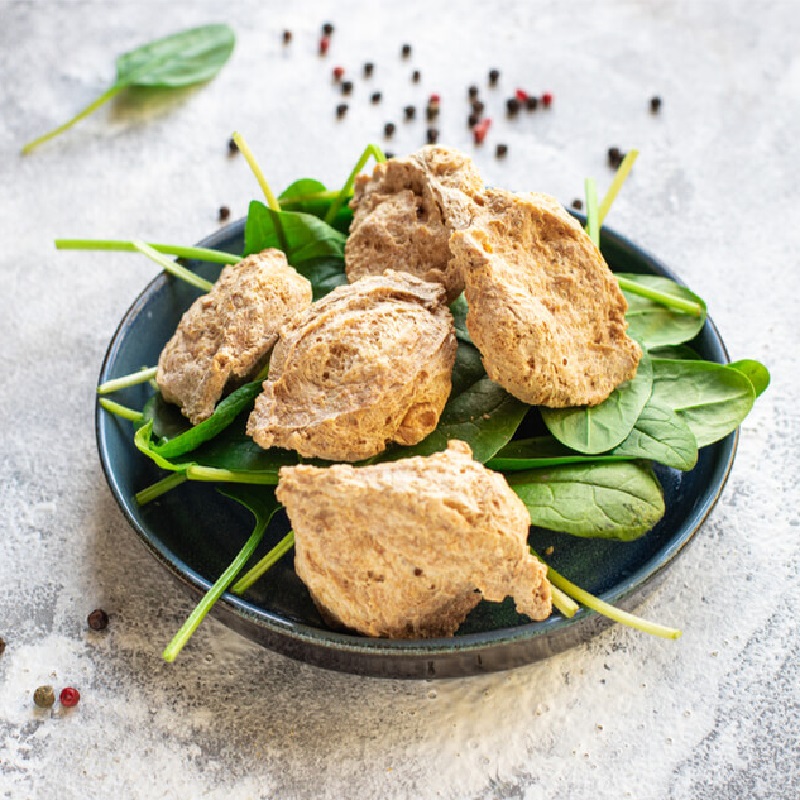
Seitan, with its remarkable ability to mimic the taste and texture of meat, stands out as an exceptional plant-based protein option. Its impressive nutritional profile makes it a reliable choice for incorporating into your diet or as a meat substitute. Such is the likeness of seitan to meat that even ardent meat-eaters may find themselves questioning their senses.
But why is it more popular than other meat alternatives? How is seitan prepared? And is it easily available? We have all the answers for you. In this article, you will learn all about seitan, its nutrition profile, health benefits, and preparation. Read on!
What Is Seitan?
Seitan is a dense and chewy plant-based meat substitute made of wheat gluteni XA structural protein found in certain grains like wheat and barley. It helps bind the food together and make it stretchy. flour. It is commonly prepared using vital wheat gluten or whole-wheat flour. Prepared wheat dough is rinsed to remove the starch, resulting in a sticky mass of protein known as seitan. It can be cooked, flavored, and used as an ingredient in burgers, deli slices, and hot dogs. Since it is prepared from wheat, this ingredient is also known as “wheat meat.”
It has a savory meat-like taste, making it easy to combine with several different ingredients and modify it to fit various cuisines. The versatility of this ingredient has contributed to its rise in popularity over the years. Though the Chinese have been using this ingredient as a meat replacement for vegans and vegetarians for centuries, it gained popularity when Buddhists started using it. Soon, it became popular in the US and picked up the Japanese-derived name “seitan” in the 1960s.
Quick Tip
Seitan also appears on the ingredient lists of food products as “vital wheat gluten.”
Apart from being known as a substitute for meat, it contains nutrients that help improve your overall health. Learn more about its nutritional value in the next section.
Seitan – Nutrition Facts
Seitan is low in fat, calories, and carbohydrates but high in protein. Additionally, it contains considerable amounts of minerals like iron, calcium, and sodium. While the nutrition content may differ based on brands and preparations, below is the nutritional data for the average seitan available in stores (1).
| Nutrients | Amount (per 100g) |
|---|---|
| Energy | 141 kcal |
| Protein | 24.7 g |
| Total lipid (fat) | 2.35 g |
| Carbohydrate | 5.88 g |
| Fiber | 1.2 g |
| Sugars | 2.35 g |
| Calcium | 24 mg |
| Iron | 1.69 mg |
| Sodium | 447 mg |
| Polyunsaturated fatty acids | 1.18 g |
Like all plant-based protein foods, seitan also contains some amounts of essential amino acids (2). However, they may be in limited amounts only.
If you are looking for other plant-based sources of protein, consider nuts, beans, tofu, and broccoli.
Wondering whether this plant-based protein is healthy for you? Read on to know if you can include it in your daily diet.
Is Seitan Healthy?
Seitan is a vegan ingredient and is usually considered healthy. Since it is low in calories, carbs, and fat, many people prefer to include it in their vegan diet. However, consuming seitan alone for your protein requirement may not be a good idea as it contains only limited amounts of essential amino acids. Therefore, it is healthy when consumed as part of a well-rounded diet including varied foods like beans, quinoa, and lentils to fill the other nutritional gaps. However, if you are sensitive to gluten, Seitan is something you should stay away from.
But how does the nutritious seitan help your health? Let us find out.
Benefits Of Seitan
Seitan is famous as a meat substitute and for being low in calories and carbohydrates. Its high amount of protein and presence of essential minerals like calcium and iron make it a healthy addition to your diet. Though there are not many scientific studies on seitan, there are a few purported advantages of adding it to your meal.
1. May Aid Weight Loss

The high amount of protein and low levels of carbohydrates in seitan may help in weight loss. A study examining a vegan diet, which also included seitan, proved that a low carbohydrate diet can help reduce weight. It has been found that there was an additional 2% advantage in body weight reduction when compared to a high carbohydrate diet (3).
2. May Prevent Cardiovascular Diseases

The increased intake of protein through gluten may help decrease the risk of cardiovascular diseases. A study conducted on a plant-based protein diet that included seitan showed an improvement in LDL cholesterol levels, which is a known risk factor for cardiovascular diseases (3).
3. May Treat Diabetes
Although there are no studies to back this claim about seitan, there is some research about plant-based diets aiding in diabetes treatment. According to a study, a plant-based low-carbohydrate diet helped lower the risk of diabetes by 22%. Such a diet may help reduce visceral fati XFat that develops over time and wraps around the internal organs and inside the abdominal cavity. and improve oxidative stress oxidative stressi XA bodily condition that occurs when the antioxidant levels are low and affects the body’s ability to prevent diseases. markers more than a conventional diet in individuals with type 2 diabetes (4).
It is important to note that there are very limited scientific studies that draw a direct link between seitan and its supposed health benefits.
Now that you know of the benefits of seitan, it is time to learn more about the flip side.
Side Effects Of Seitan
As healthy as seitan is claimed to be, it also has some potential adverse effects.
1. Allergic Reactions

Since seitan is made from wheat gluten, it may cause allergic reactions in people who are allergic to gluten. So, people with a wheat allergy, gluten intolerance, or celiac diseasei XAn autoimmune disorder triggered due to the consumption of gluten, causing fatigue, bloating, and diarrhea. should avoid seitan as it may cause symptoms like bloating, abdominal pain, fatigue, indigestion, or diarrhea (5).
2. Affects Gut Health
Though there is not enough scientific evidence to prove seitan affects gut health, there is some anecdotal evidence that it may cause a leaky gut syndromei that allows larger particles to pass through into the bloodstream. This is called increased intestinal permeability (6).
3. High In Sodium
Since most people consume pre-made seitan from restaurants and stores, it may contain high quantities of sodium. Thus, this ultra-processed product can contribute to high blood pressure. Moreover, it may also contain preservatives and additives that may cause more harm than good for your health.
Therefore, it is best to prepare seitan at home instead of buying it pre-made. Read on to learn how to prepare seitan.
How To Make Your Own Seitan
Ingredients
For The Dough
- 6 cups whole wheat flour
- 2 cups cold water
For The Broth
- 4 cups water
- 1/4 cup soy sauce
- 1/2 onion chopped
- 1 tablespoon miso paste
- 1 medium tomato cut in quarters
- 2 cloves garlic
Method
- Mix water and flour to make stiff-but-cohesive dough.
- Place the dough in a bowl.
- Pour the water into the bowl, cover it, and leave it for 4-8 hours.
- Knead the dough and rinse it until the water runs clear.
- Squeeze the dough to remove water and air.
- Cut the gluten (dough) into small pieces.
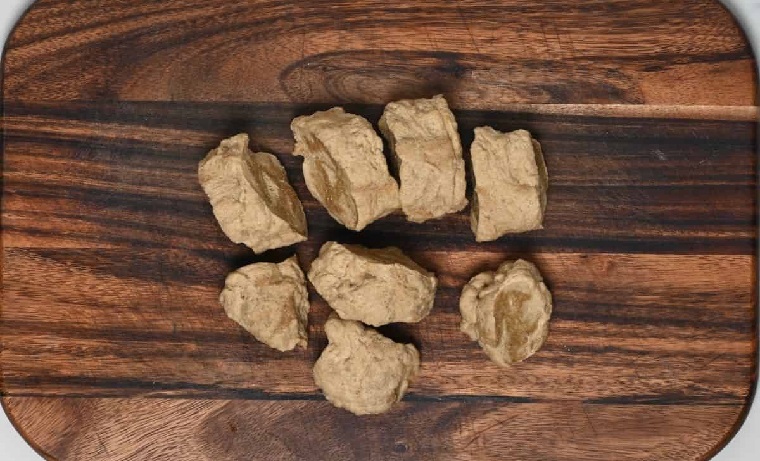
- Mix all the ingredients for the broth.
- Bring the broth to a boil.
- Add the gluten pieces to the boiling broth.
- Turn the heat down to a simmer.
- Cook and stir the gluten pieces for about 30 minutes.
- Discard the vegetable pieces.
- Drain and saute the seitan in a little oil to use it right away.

You can use seitan as a substitute for a burger patty, breakfast sausage, or even as a filling in burritos. Check out some interesting recipes below.
Seitan Recipes You Can Try At Home
1. Seitan Twizzlers
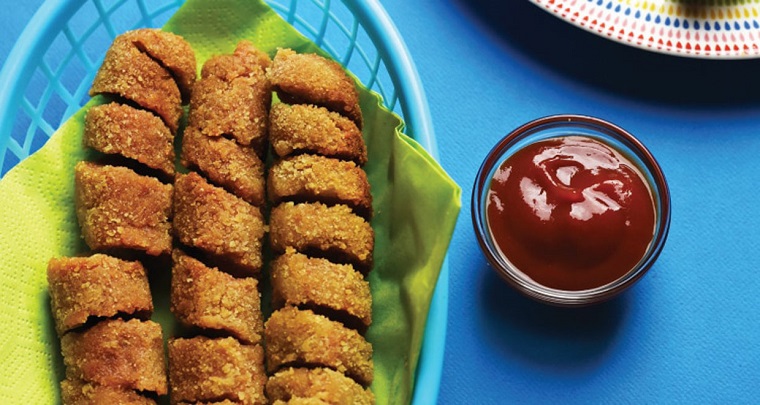
Ingredients
- Seitan cut into sausage shapes
- 150 g plain flour
- 1 teaspoon sugar
- 1 teaspoon garlic powder
- 1 teaspoon smoked paprika
- 1 teaspoon onion powder
- 120 ml soya milk
- Oil for frying
Method
- Roll up the seitan pieces tightly in tin foil.
- Place the sausages into a steamer for 45 minutes.
- Allow them to cool for 10 minutes.
- Combine the flour, paprika, sugar, onion powder, and garlic powder.
- Place the seitan sausages onto skewers.
- Cut the seitan into a spiral.
- Roll the seitan into the soya milk mixture.
- Roll it in the flour and spice mixture for an even coating.
- Heat oil in a frying pan over medium-high heat.
- Fry each twizzler for 3 to 4 minutes on each side.
- Remove the skewers and serve with a dip of your choice.
2. Seitan Saag

Ingredients
- 1 tablespoon peanut oil
- 1 large onion
- 1 peeled and finely chopped ginger
- ½ teaspoon salt
- 300 g shredded seitan
- 1 teaspoon sugar
- 2 teaspoon curry powder
- ½ teaspoon turmeric
- ½ teaspoon cumin
- 1 dash cinnamon
- 1 teaspoon minced chili
- 1 tablespoon tomato paste
- 200 g diced fresh tomatoes
- 235 ml water
- 2 handfuls spinach
Method
- Saute the onion in peanut oil with the ginger and some salt.
- Add the seitan when the onion becomes translucent.
- Fry until the onion is slightly browned.
- Add sugar, chili, salt, sugar, curry powder, turmeric, cumin, cinnamon, and tomato paste.
- Stir till it gets a brown color.
- Add diced fresh tomatoes.
- Stir and cook the tomatoes for about 5 minutes.
- Pour water and bring the heat up and cook until you have half the amount of liquid left in the pan.
- Once cooked, reduce the heat and add the spinach.
3. Seitan Mole
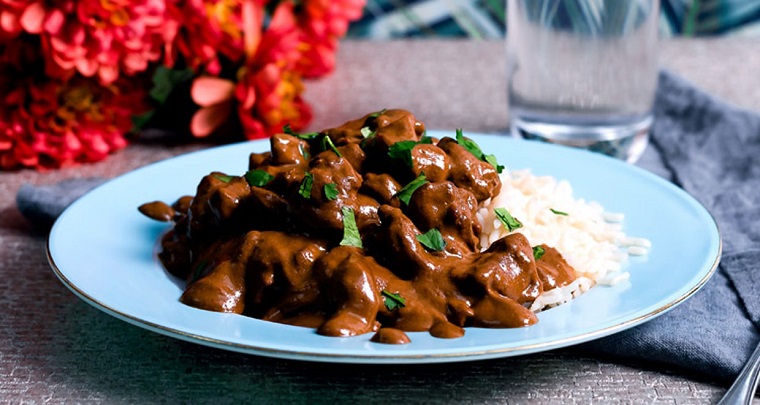
Ingredients
- 3 tablespoons of smoked paprika
- 1 tablespoon sesame seeds
- 3 tablespoons of raisins
- 3 tablespoons of maple syrup
- 1 tablespoon cider vinegar
- 2 tablespoons of olive oil
- 1 tablespoon dried chili flakes
- 3 tablespoons of chopped almonds
- 1 teaspoon dried oregano
- 2 chopped onions
- 1 tablespoon cacao powder
- 1 tablespoon water
- 600 ml vegetable stock
- 450 g seitan pieces
Method
- Toast the paprika, chili flakes, sesame seeds, almonds, cinnamon and oregano over medium heat.
- Blend these with raisins, onion, maple syrup, cacao powder, cider vinegar, and water until a smooth paste is formed.
- Warm 1 tablespoon olive oil over medium heat.
- Add the paste and cook for 3 to 4 minutes until the paste thickens.
- Slowly add the stock whilst whisking
- Bring it to a boil and cook for 10 to 15 minutes.
- Add the remaining tablespoon of olive oil and seitan to a frying pan
- Fry the seitan for 3 to 4 minutes on medium heat until crispy
- Add this to the mole sauce before serving.
The Bottom Line
Seitan is a protein-rich ingredient that can mimic the look and taste of meat. Seitan’s nutrition profile claims to have low carbohydrates and fat, making it a healthy substitute for animal protein. However, it does not have enough amounts of some essential amino acids. Nevertheless, this plant-based protein may help you lose weight and prevent cardiovascular diseases. You can prepare it at home or buy pre-packed seitan to add to your daily diet. Regardless, ensure you do not have are not allergic to gluten or wheat products before consuming it.
Frequently Asked Questions
Is seitan a complete protein?
No, seitan is not a complete protein source. Though it is high in protein, it lacks essential amino acids.Which is better – seitan or tofu?
The presence of certain essential nutrients makes tofu better than seitan. However, seitan is easier to cook with as it has a better taste and texture than tofu.What does seitan taste like?
Seitan has a dense, slightly rubbery texture and savory flavor that is akin to meat.Is homemade seitan healthy?
Homemade seitan is comparatively healthier than pre-packed seitan, which may contain high amounts of sodium and preservatives.
Key Takeaways
- Seitan is a plant-based alternative to meat derived from animals.
- It is high in protein and low in fat and carbohydrates.
- You can prepare it at home or buy pre-packed seitan and use it as a substitute for burgers, sausages, or burritos.
- People with gluten and wheat allergies should not consume seitan.



















